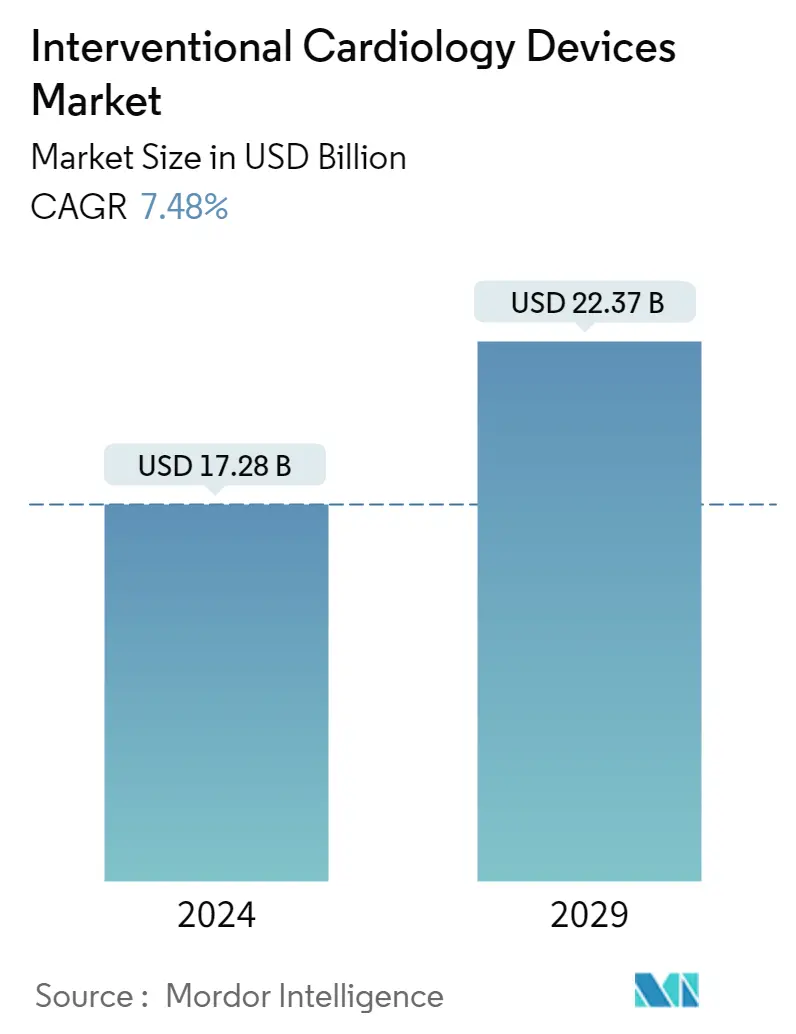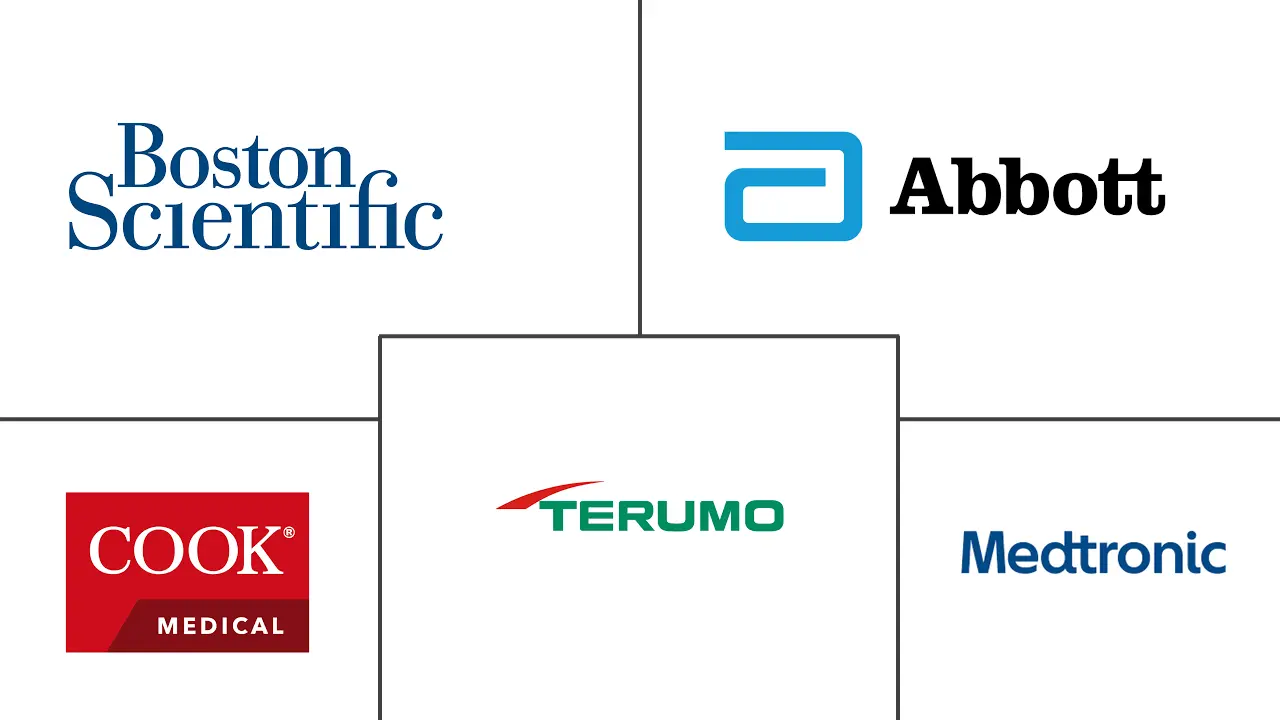Market Size of Interventional Cardiology Devices Industry

| Study Period | 2019 - 2029 |
| Market Size (2024) | USD 17.28 Billion |
| Market Size (2029) | USD 22.37 Billion |
| CAGR (2024 - 2029) | 7.48 % |
| Fastest Growing Market | Asia-Pacific |
| Largest Market | North America |
| Market Concentration | Medium |
Major Players
*Disclaimer: Major Players sorted in no particular order |
Interventional Cardiology Devices Market Analysis
The Interventional Cardiology Devices Market size is estimated at USD 17.28 billion in 2024, and is expected to reach USD 22.37 billion by 2029, growing at a CAGR of 7.48% during the forecast period (2024-2029).
The COVID-19 pandemic impacted several interventional cardiology (IC) and electrophysiology (EP) operations to be performed globally. For instance, according to an article published in PLOS ONE in September 2022, during the COVID-19 pandemic, there was a reduction in percutaneous coronary intervention (PCI) volumes and higher risk-adjusted mortality. COVID-19-positive patients experienced significantly worse outcomes. Thus, the COVID-19 pandemic had an adverse impact on the market's growth in its preliminary phase.
Although the COVID-19 pandemic significantly impacted market growth in the initial phases, with the help of government initiatives, innovation, and digital health, the market has recovered. For instance, according to an article published by Current Cardiology Reports in March 2022, remote telehealth monitoring, telehealth clinic visits, and patient education through social media were implemented and showed benefits to those at higher risk of cardiovascular events.
Additionally, robotic PCI emerged as a promising strategy in experienced centers during the pandemic, and it facilitated procedural distancing, minimized exposure risk, and decreased PPE cost. Hence, with better access to healthcare access and the implementation of telemedicine during the pandemic, the market was expected to gain its growth pace over the forecast period.
Furthermore, the major factors for the growth of the interventional cardiology devices market include the growing prevalence of coronary artery diseases (CADs), technological advancements in interventional cardiology devices, and the growing demand for minimally invasive treatment globally. For instance, according to the British Heart Foundation's Report published in July 2022, 7.6 million people in the United Kingdom lived with heart and circulatory diseases in 2021, out of which 4 million were men and 3.6 million were women. Therefore, the increasing burden of heart disease is anticipated to boost the usage of interventional cardiology devices, in turn driving the market growth over the forecast period.
Moreover, market players are competing to launch advanced products for better treatment and have invested in research and development programs to improve their existing product lines and launch new product portfolios. For instance, in February 2022, Cardiovascular Systems, Inc. partnered with Innova Vascular, Inc. (Innova) to develop a full line of novel thrombectomy devices. Similarly, in July 2021, ORIGIN SC and ORIGIN NC, two high-performance balloons for vessel preparation, were launched by MedAlliance for patients suffering from life-threatening coronary and peripheral arterial disease. Such development is expected to drive the growth of the market over the forecast period.
Hence, as per the aforementioned factors, such as the growing prevalence of coronary artery diseases (CADs), technological advancements in interventional cardiology devices, and the growing demand for minimally invasive treatment globally, the interventional cardiology devices market is likely to grow over the forecast period. However, a stringent regulatory scenario for manufacturing interventional cardiology devices and the availability of effective first-line treatments are expected to restrain the market's growth.
Interventional Cardiology Devices Industry Segmentation
As per the scope of this report, interventional cardiology is the sub-specialty of cardiology that uses intravascular catheter-based techniques with fluoroscopy to treat coronary artery, valvular, and congenital cardiac diseases. The interventional cardiology devices market is segmented by product type (coronary stents (bare stents, drug-eluting stents, and bioabsorbable stents), catheters (angiography catheters, intravascular ultrasound (IVUS) catheters, and percutaneous transluminal coronary angioplasty (PTCA) guiding catheters), percutaneous transluminal coronary angioplasty (PTCA) balloons, percutaneous transluminal coronary angioplasty (PTCA) guide wires, and other product types) and geography (North America, Europe, Asia-Pacific, Middle East and Africa, and South America). The report also covers the estimated market sizes and trends for 17 countries across major regions globally. The report offers the value (in USD) for the above segments.
| By Product Type | |||||
| |||||
| |||||
| Percutaneous Transluminal Coronary Angioplasty (PTCA) Balloons | |||||
| Percutaneous Transluminal Coronary Angioplasty (PTCA) Guide Wires | |||||
| Other Product Types |
| Geography | ||||||||
| ||||||||
| ||||||||
| ||||||||
| ||||||||
|
Interventional Cardiology Devices Market Size Summary
The interventional cardiology devices market is poised for significant growth over the forecast period, driven by the increasing prevalence of coronary artery diseases, technological advancements, and the rising demand for minimally invasive treatments. Despite the initial setbacks caused by the COVID-19 pandemic, which led to a reduction in procedures and adverse outcomes for infected patients, the market has shown resilience. The adoption of digital health solutions, such as telehealth and remote monitoring, along with innovations like robotic percutaneous coronary interventions, has facilitated recovery and is expected to sustain growth. The market's expansion is further supported by ongoing research and development efforts, with companies investing in advanced product offerings to enhance treatment outcomes.
North America is anticipated to be a key region for market growth, supported by favorable government initiatives, high patient awareness, and a growing geriatric population. The region's market is characterized by the presence of major players developing novel technologies and forming strategic partnerships to enhance their product portfolios. The drug-eluting stents segment, in particular, is expected to experience robust growth due to the introduction of sophisticated systems and their benefits in preventing restenosis. However, the market faces challenges from stringent regulatory environments and the availability of effective first-line treatments, which may temper growth prospects. Overall, the interventional cardiology devices market is set to expand, driven by technological innovations and increasing healthcare access.
Interventional Cardiology Devices Market Size - Table of Contents
-
1. MARKET DYNAMICS
-
1.1 Market Overview
-
1.2 Market Drivers
-
1.2.1 Growing Prevalence of Coronary Artery Diseases (CADs)
-
1.2.2 Technological Advancements in Interventional Cardiology Devices
-
1.2.3 Growing Demand for Minimally Invasive Treatment
-
-
1.3 Market Restraints
-
1.3.1 Stringent Regulatory Scenario
-
1.3.2 Availability of Effective First-line Treatments
-
-
1.4 Porter's Five Forces Analysis
-
1.4.1 Threat of New Entrants
-
1.4.2 Bargaining Power of Buyers/Consumers
-
1.4.3 Bargaining Power of Suppliers
-
1.4.4 Threat of Substitute Products
-
1.4.5 Intensity of Competitive Rivalry
-
-
-
2. MARKET SEGMENTATION (Market Size by Value - USD)
-
2.1 By Product Type
-
2.1.1 Coronary Stents
-
2.1.1.1 Bare Stents
-
2.1.1.2 Drug-eluting Stents
-
2.1.1.3 Bioabsorbable Stents
-
-
2.1.2 Catheters
-
2.1.2.1 Angiography Catheters
-
2.1.2.2 Intravascular Ultrasound (IVUS) Catheters
-
2.1.2.3 Percutaneous Transluminal Coronary Angioplasty (PTCA) Guiding Catheters
-
-
2.1.3 Percutaneous Transluminal Coronary Angioplasty (PTCA) Balloons
-
2.1.4 Percutaneous Transluminal Coronary Angioplasty (PTCA) Guide Wires
-
2.1.5 Other Product Types
-
-
2.2 Geography
-
2.2.1 North America
-
2.2.1.1 United States
-
2.2.1.2 Canada
-
2.2.1.3 Mexico
-
-
2.2.2 Europe
-
2.2.2.1 Germany
-
2.2.2.2 United Kingdom
-
2.2.2.3 France
-
2.2.2.4 Italy
-
2.2.2.5 Spain
-
2.2.2.6 Rest of Europe
-
-
2.2.3 Asia-Pacific
-
2.2.3.1 China
-
2.2.3.2 Japan
-
2.2.3.3 India
-
2.2.3.4 Australia
-
2.2.3.5 South Korea
-
2.2.3.6 Rest of Asia-Pacific
-
-
2.2.4 Middle East and Africa
-
2.2.4.1 GCC
-
2.2.4.2 South Africa
-
2.2.4.3 Rest of Middle East and Africa
-
-
2.2.5 South America
-
2.2.5.1 Brazil
-
2.2.5.2 Argentina
-
2.2.5.3 Rest of South America
-
-
-
Interventional Cardiology Devices Market Size FAQs
How big is the Interventional Cardiology Devices Market?
The Interventional Cardiology Devices Market size is expected to reach USD 17.28 billion in 2024 and grow at a CAGR of 7.48% to reach USD 22.37 billion by 2029.
What is the current Interventional Cardiology Devices Market size?
In 2024, the Interventional Cardiology Devices Market size is expected to reach USD 17.28 billion.

